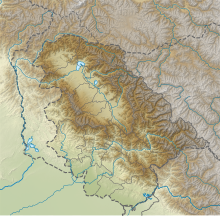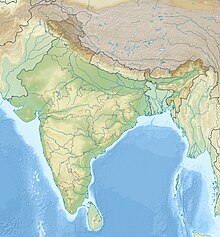Gufkral
| Gufkral Cave | |
|---|---|
| Coordinates | 33°55′30″N 75°6′30″E / 33.92500°N 75.10833°E |
| Discovery | 1981 |
 | |
Gufkral ('guf' means cave and 'kral' means potter) is a site inhabited by potters who utilize the caves. Caves and archeological site are located at Banmir village in the Tral Tehsil of the Pulwama District, in the Kashmir Valley of Jammu and Kashmir, India. The cave of Gufkral is one of the oldest cave in Kashmir and some estimates trace their origin 2000-3000 BCE.[1] [2]
The excavation by an Archaeological Survey of India team led by A K Sharma from 18 August to 20 October in 1981 revealed that the site was occupied for five periods from the Aceramic Neolithic to Megalithic periods.[3][4][5][6]
Location
[edit]Gufkral is situated 41 km (25 mi) southeast of Srinagar near the tehsil town of Tral in the Pulwama district of the Kashmir Valley in Jammu and Kashmir, India.[7][8]
References
[edit]- ^ "Gufkral, the endangered legacy of cavemen, metallurgists and Shahmar Pals". Greater Kashmir. 2018-08-03. Retrieved 2021-01-23.
- ^ A. K. SHARMA GU'fkraI1981: An Aceramic Neolithic Site in the Kashmir Valley 1982
- ^ "Neolithic site Gufkral facing official neglect". The INS News. Retrieved 2021-01-24.
- ^ "Gufkral | archaeological site, India". Encyclopedia Britannica. Retrieved 2021-01-24.
- ^ SHARMA, A. K. (1982). "Gufkral 1981: An Aceramic Neolithic Site in the Kashmir Valley". Asian Perspectives. 25 (2): 23–41. ISSN 0066-8435. JSTOR 42928083.
- ^ "Tral's Gufkrals'". Kashmir Life. 2019-01-23. Retrieved 2021-01-24.
- ^ rashid, basharat. "The Potters of Bonn Mir, and the Gufkral Neolithic Cave Site". The Citizen. Retrieved 2021-01-24.
- ^ Ahmad, Syed Mustafa (2020-04-30). "Neolithic Age with respect to Mehargarh, Burzahom and Gufkral". Asnaav. Retrieved 2021-01-24.



